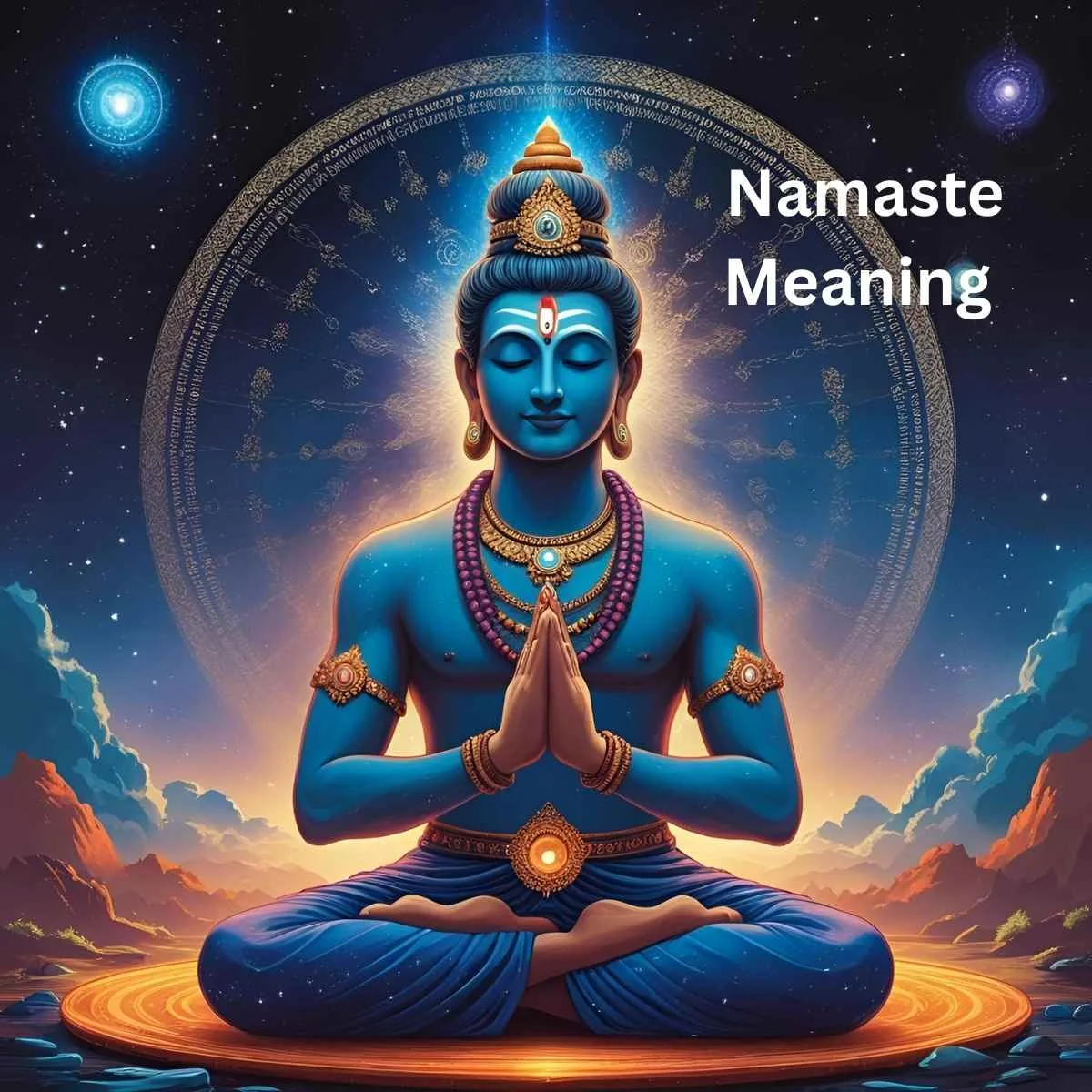For many people around the world, Namaste is more than just a greeting—it’s a window into ancient wisdom, spiritual connection, and cultural respect.
You’ve probably heard the word at the end of a yoga class ritual, seen it in wellness spaces, or come across it in spiritual books. But what does Namaste really mean? Where does it come from, and how should you use it properly?
This guide goes deep into the namaste meaning, its history, cultural significance, spiritual symbolism, and practical usage. Whether you’re a yoga beginner, a cultural enthusiast, or simply curious, this article unpacks every layer of this timeless word.
What Does Namaste Mean?
At its core, Namaste is a Sanskrit word combining two parts:
- Namah (नमः) – “to bow,” “to honor,” or “to pay respect.”
- Te (ते) – “to you.”
So, the literal translation of Namaste is “I bow to you.” But that’s just the surface. In spiritual traditions, the deeper interpretation is “the divine in me honors the divine in you.” This phrase captures the soul-to-soul connection at the heart of Indian spirituality.
When someone asks, “What does Namaste mean?” the answer isn’t just about language—it’s about intention. Saying Namaste is more than saying “hello.” It’s acknowledging another person with humility, respect, and a recognition of shared divinity.
Namaste Pronunciation
Many people mispronounce Namaste, especially in Western yoga communities. The correct Namaste pronunciation is:
“Nuh-muh-stay” (with equal stress on all syllables).
Common mistakes include overemphasizing the last syllable (e.g., “nah-MAH-stay”). Keeping the rhythm even helps honor the word’s authenticity.
Namaste in Different Languages
The beauty of Namaste is that it transcends linguistic boundaries while retaining its essence.
| Language | Meaning / Usage |
|---|---|
| Hindi | Everyday respectful greeting, often used when meeting elders. |
| English | Translated as “hello,” “greetings,” or “I honor you.” |
| Sanskrit | Original root language—“I bow to you.” |
| Urdu | Borrowed in cultural contexts, less common in daily speech. |
| Spanish | Adopted as “Namasté,” used in yoga and meditation spaces. |
| Japanese | Sometimes confused with bowing traditions but not linguistically related. |
Fact: While Namaste is sometimes assumed to be universal across Asia, it is primarily rooted in South Asian greeting traditions, particularly Hindu culture.
Cultural and Historical Origins of Namaste
The origins of Namaste trace back thousands of years to the Vedic texts of ancient India. The Sanskrit word Namaste appears in hymns where sages offered respect to deities, nature, and one another.
Over centuries, the word integrated into:
- Hinduism: A respectful greeting for both humans and gods.
- Buddhism: Used in monastic rituals and meditation practices.
- Jainism and Sikhism: Incorporated into prayers and greetings.
Namaste became not just a phrase, but a reflection of Hindu cultural significance, symbolizing humility and interconnectedness.
The Spiritual Meaning of Namaste
Spiritually, the meaning of Namaste goes far beyond a polite greeting. When you place your palms together and say the word, you’re making a profound acknowledgment:
“The divine in me honors the divine in you.”
This expression is closely tied to yoga spirituality and the heart chakra connection. Joining the palms at the heart center represents unity, balance, and devotion. It’s a way of seeing others as sacred beings rather than just physical forms.
Namaste is also considered a spiritual greeting in India, often used in temples, meditation, and sacred ceremonies.
The Namaste Gesture (Anjali Mudra)
Namaste is inseparable from its physical gesture, known as Anjali Mudra (the prayer-like position of hands at the heart).
Anjali Mudra Meaning
- Anjali – “offering”
- Mudra – “seal” or “gesture”
Together, it means the gesture of offering or reverence.
The Namaste gesture symbolizes:
- Unity of mind, body, and spirit.
- Balance between left and right energy channels.
- Surrender to divine consciousness.
This is why yoga teachers often end class with yoga greeting Namaste, bowing slightly with palms pressed together.
Namaste vs Namaskar
While often used interchangeably, Namaste vs Namaskar have subtle differences:
- Namaste is more personal, typically used when addressing individuals.
- Namaskar is broader, often used to greet groups or elders.
Both carry the same essence of respect and humility. Interestingly, Surya Namaskar (Sun Salutation) in yoga derives from this word, meaning “to bow to the sun.”
Namaste in Yoga and Wellness Practices
In the modern world, most people encounter Namaste in yoga studios. But what is the meaning of Namaste in yoga?
- Yoga teacher respect: At the end of class, teachers say Namaste to honor students.
- Yoga closing rituals: Saying Namaste symbolizes the completion of a sacred practice.
- Yoga philosophy terms: It connects to mindfulness, gratitude, and humility.
- Meditation greetings: Used before or after meditation to set spiritual tone.
For beginners, this yoga etiquette might feel ceremonial, but it’s a meaningful practice rooted in centuries of tradition.
When and How to Use Namaste
If you’re wondering how to use Namaste, context matters.
When to Use It:
- Greeting elders or spiritual teachers.
- Ending a yoga or meditation session.
- In formal or sacred settings in India and Nepal.
When Not to Use It:
- As casual slang (“Namaslay,” “Nama’stay in bed”)—this is considered a misuse of Namaste.
- Overusing it in daily conversation outside cultural or spiritual context.
The best approach is to use Namaste respectfully, especially when engaging with South Asian yoga traditions.
Other Expressions Related to Namaste
India is home to diverse greetings, each carrying deep meaning.
- Namaskar: Formal and respectful greeting.
- Pranam: A deeper bow, often used in religious contexts.
- Sat Sri Akal: Sikh greeting meaning “God is eternal.”
- Western equivalents: Bow in Japan, Thai “Wai”, handshake in the West.
These parallels highlight how respectful bowing gestures exist across cultures.
The Symbol of Namaste
Namaste is not only spoken—it has become a symbol in modern culture.
- Used in mandalas, tattoos, and yoga artwork.
- Found in yoga accessories and wellness branding.
- Sometimes misused in pop culture marketing.
Warning on Cultural Appropriation
While Namaste has been commercialized in wellness industries, authors like Susanna Barkataki (Embrace Yoga’s Roots) emphasize practicing it with awareness and respect. Using Namaste without understanding its depth risks turning it into a decorative label rather than a sacred word.
Misinterpretations and Modern Usage
In recent years, Namaste has gone global—but not without controversy.
- Misuse in yoga culture: “Namaslay” shirts or “Nama’stay in bed” mugs trivialize its depth.
- Yoga cultural appropriation: Critics argue Western yoga often strips Namaste from its spiritual roots.
- Balance needed: You can embrace Namaste respectfully by learning its meaning and cultural background.
Prominent yoga teachers like Aadil Palkhivala and B.K.S. Iyengar remind practitioners that Namaste is a yoga lifestyle practice, not a fashion slogan.
Conclusion
Namaste is far more than a word—it’s a philosophy. Rooted in Sanskrit, it carries layers of meaning that touch language, culture, spirituality, and wellness.
- In daily Indian greeting traditions, Namaste is a respectful “hello.”
- In yoga spirituality, it symbolizes the unity of souls and the acknowledgment of divine essence.
- As a gesture (Anjali Mudra), it connects body, mind, and spirit.
When used with understanding, Namaste becomes a bridge—between teacher and student, self and divine, East and West.
So next time you hear it at the end of a yoga class or say it to greet someone, remember its essence:
“The divine in me honors the divine in you.”
Frequently Asked Questions About Namaste
Is Namaste religious or secular?
Both. In India, Namaste is a secular daily greeting. Spiritually, it has deep roots in Hindu and Buddhist traditions.
Should non-Hindus say Namaste?
Yes, but always with respect and understanding of its cultural significance.
What’s the difference between Namaste and Namaskar?
Namaste is more personal; Namaskar is broader and formal.
Why do yoga teachers say Namaste?
It’s a respectful closing ritual acknowledging the student-teacher connection.
Is Namaste used in Buddhism?
Yes, especially in Tibetan and Nepalese Buddhist traditions as a gesture of reverence.



